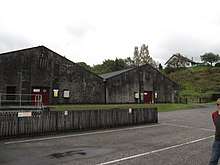Teratosphaeriaceae
Teratosphaeriaceae is a family of fungi in the order Capnodiales.
| Teratosphaeriaceae | |
|---|---|
 | |
| Baudoinia compniacensis growing on Blair Athol distillery, feeding on the angel's share | |
| Scientific classification | |
| Kingdom: | |
| Division: | |
| Subdivision: | |
| Class: | |
| Subclass: | |
| Order: | |
| Family: | Teratosphaeriaceae |
| Genera | |
| |
History
In 2007, this family was recognized as distinct from the genus Mycosphaerella, where it had previously been located, based on phylogenies constructed with the Large Subunit (LSU) of ribosomal DNA.[1] In general, many fungi in the Mycosphaerellaceae and Teratosphaeriaceae are thought to be widespread, yet there is still little known about their individual distributions or the range of hosts that they inhabit.[2] After the family was formally split out from Mycosphaerella in 2007,[1] many new species have been described in this family including a number of causal agents in leaf diseases and stem cankers of Eucalyptus in Uruguay[2][3] and Australia.[4][5]
Habitat
This family of fungi is notable in that it contains a number of extremeotolerant, so-called black yeast fungi.[1] A number of these black yeast fungi in the Teratosphaeriaceae are considered 'rock-inhabiting', and manage to survive on the often-harsh exposed surfaces of rocks[6] in a range of extreme climates, including in Antarctica.[7] While some of the members of this family live in harsh environments, including the newly described genus Acidiella that grows in highly acidic soils (pH < 3) in Europe,[8] other closely related species are found as lichens or on plant surfaces.[9] This family, for example, contains a number of previously recognized leaf spot pathogens and endophytes.[10][11] Sequences from the plant pathogen Teratosphaeria microspora were even found in a high-throughput screen of fungal spores in indoor dust.[12]
References
- Crous, P. W.; U. Braun; Johannes Z. Groenewald (2007). "Mycosphaerella is polyphyletic". Studies in Mycology. 58: 1–32. doi:10.3114/sim.2007.58.01. PMC 2104738. PMID 18490994.
- Pérez, C. A.; M. J. Wingfield; N. A. Altier; R. A. Blanchette (October 2009). "Mycosphaerellaceae and Teratosphaeriaceae associated with Eucalyptus leaf diseases and stem cankers in Uruguay". Forest Pathology. 39 (5): 349–360. CiteSeerX 10.1.1.722.6028. doi:10.1111/j.1439-0329.2009.00598.x.
- Pérez, C. A.; M. J. Wingfield; N. Altier; R. A. Blanchette (2013-03-01). "Species of Mycosphaerellaceae and Teratosphaeriaceae on native Myrtaceae in Uruguay: evidence of fungal host jumps". Fungal Biology. 117 (2): 94–102. doi:10.1016/j.funbio.2012.12.002. hdl:2263/30796. PMID 23452947.
- Crous, P. W.; B. A. Summerell; A. J. Carnegie; M. J. Wingfield; Johannes Z. Groenewald (2009-12-31). "Novel species of Mycosphaerellaceae and Teratosphaeriaceae". Persoonia. 23: 119–146. doi:10.3767/003158509X479531. PMC 2802729. PMID 20198165.
- Pérez, Guillermo; Bernard Slippers; Michael J. Wingfield; Brenda D. Wingfield; Angus J. Carnegie; Treena I. Burgess (2012-08-10). "Cryptic species, native populations and biological invasions by a eucalypt forest pathogen". Molecular Ecology. 21 (18): 4452–4471. doi:10.1111/j.1365-294X.2012.05714.x. PMID 22882273.
- Ruibal, C.; G. Platas; G. F. Bills (2008-12-01). "High diversity and morphological convergence among melanised fungi from rock formations in the Central Mountain System of Spain". Persoonia. 21: 93–110. doi:10.3767/003158508X371379. PMC 2846131. PMID 20396580.
- Ruibal, C.; C. Gueidan; L. Selbmann; A. A. Gorbushina; P. W. Crous; Johannes Z. Groenewald; L. Muggia; M. Grube; D. Isola; C. L. Schoch; J. T. Staley; F. Lutzoni; G. S. de Hoog (2010-03-05). "Phylogeny of rock-inhabiting fungi related to Dothideomycetes". Studies in Mycology. 64: 123–133–S7. doi:10.3114/sim.2009.64.06. PMC 2816969. PMID 20169026.
- Hujslová, Martina; Alena Kubátová; Martin Kostovčík; Miroslav Kolařík (2012-10-07). "Acidiella bohemica gen. et sp. nov. and Acidomyces spp. (Teratosphaeriaceae), the indigenous inhabitants of extremely acidic soils in Europe". Fungal Diversity. 58: 33–45. doi:10.1007/s13225-012-0176-7.
- Gostinčar, Cene; Lucia Muggia; Martin Grube (2012). "Polyextremotolerant black fungi: oligotrophism, adaptive potential, and a link to lichen symbioses". Frontiers in Microbiology. 3: 390. doi:10.3389/fmicb.2012.00390. PMC 3492852. PMID 23162543.
- Kemler, Martin; Jeff Garnas; Michael J. Wingfield; Marieka Gryzenhout; Kerry-Anne Pillay; Bernard Slippers (2013-12-16). "Ion Torrent PGM as Tool for Fungal Community Analysis: A Case Study of Endophytes in Eucalyptus grandis Reveals High Taxonomic Diversity". PLoS ONE. 8 (12): –81718. doi:10.1371/journal.pone.0081718. PMC 3864840. PMID 24358124.
- Crous, P. W.; Johannes Z. Groenewald (2011-07-30). "Why everlastings don't last". Persoonia. 26: 70–84. doi:10.3767/003158511X574532. PMC 3160795. PMID 22025805.
- Adams, Rachel I.; Anthony S. Amend; John W. Taylor; Thomas D. Bruns (2013-07-24). "A Unique Signal Distorts the Perception of Species Richness and Composition in High-Throughput Sequencing Surveys of Microbial Communities: a Case Study of Fungi in Indoor Dust". Microbial Ecology. 66 (4): 735–741. doi:10.1007/s00248-013-0266-4. PMC 3824195. PMID 23880792.